Griffiths D. Head First Statistics
Подождите немного. Документ загружается.

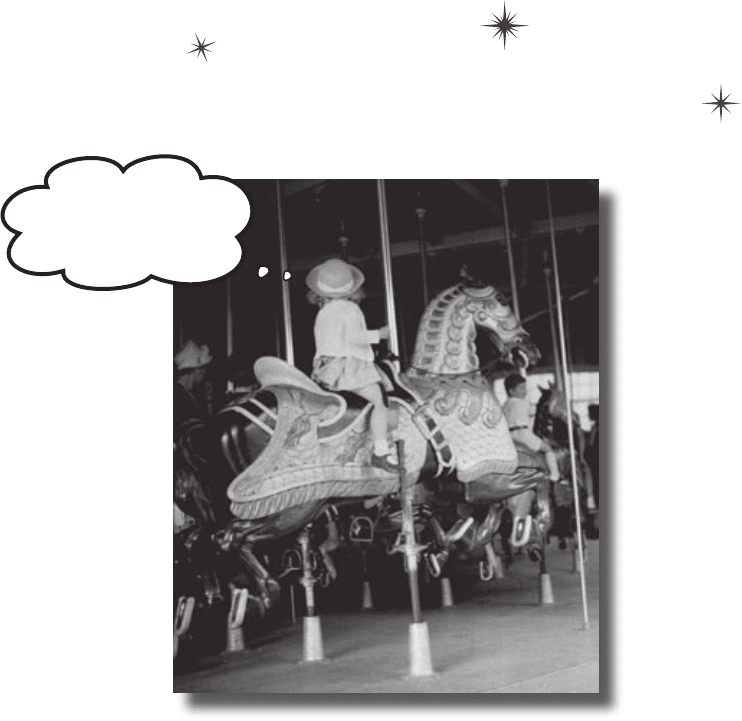
this is a new chapter 521
using hypothesis tests
13
Look At The Evidence
I thought you
said these were
real horses.
Not everything you’re told is absolutely certain.
The trouble is, how do you know when what you’re being told isn’t right? Hypothesis
tests give you a way of using samples to test whether or not statistical claims are likely
to be true. They give you a way of weighing the evidence and testing whether extreme
results can be explained by mere coincidence, or whether there are darker forces at
work. Come with us on a ride through this chapter, and we’ll show you how you can use
hypothesis tests to confirm or allay your deepest suspicions.

522 Chapter 13
Statsville’s new miracle drug
Statsville’s leading drug company has produced a new remedy for
curing snoring. Frustrated snorers are flocking to their doctors in
hopes of finding nightly relief.
The drug company claims that their miracle drug cures 90% of
people within two weeks, which is great news for the people with
snoring difficulties. The trouble is, not everyone’s convinced.
IS your SnorIng geTTIng you down?
Then you need new SnoreCull,
The ulTImaTe remedy for SnorIng.
SnoreCull CureS 90%
of SnorerS wIThIn 2 weekS.
Cull ThoSe SnoreS wITh new SnoreCull
S
nore
C
ull
S
nore
C
ull
48 T
ableTS
the ultimate snoring remedy?
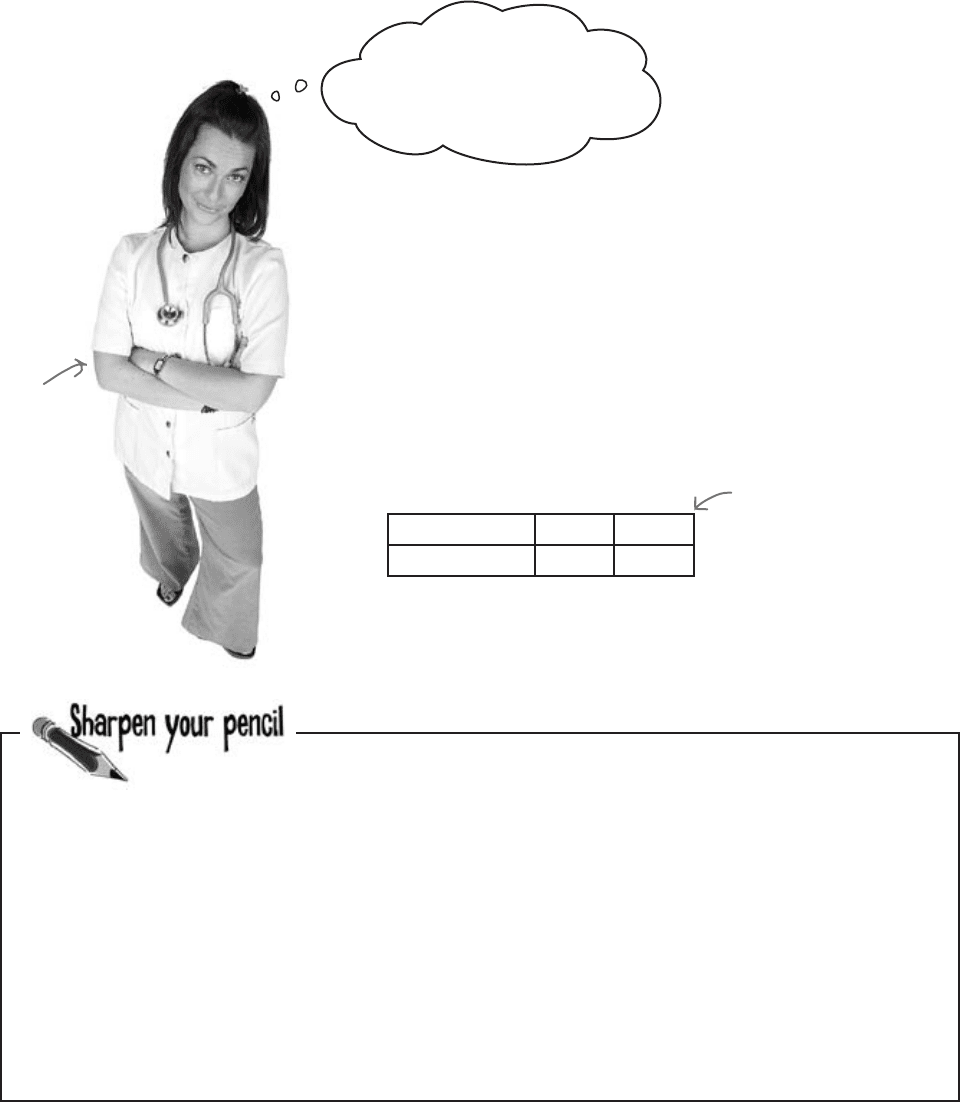
you are here 4 523
using hypothesis tests
The doctor at the Statsville Surgery has been prescribing SnoreCull
to her patients, but she’s disappointed by the results. She decides to
conduct her own trial of the drug.
She takes a random sample of 15 snorers and puts them on a course
of SnoreCull for two weeks. After two weeks, she calls them back in
to see whether their snoring has stopped.
Here are the results:
If the drug cures 90% of people, how many people in the sample
of 15 snorers would you expect to have been cured? What sort of
distribution do you think this follows?
I’m not sure these claims are
true. If they were, more of
my patients would be cured.
Cured? Yes No
Frequency
11 4
All the doctor records is
whether or not the patients
snoring has been cured.
Doctor
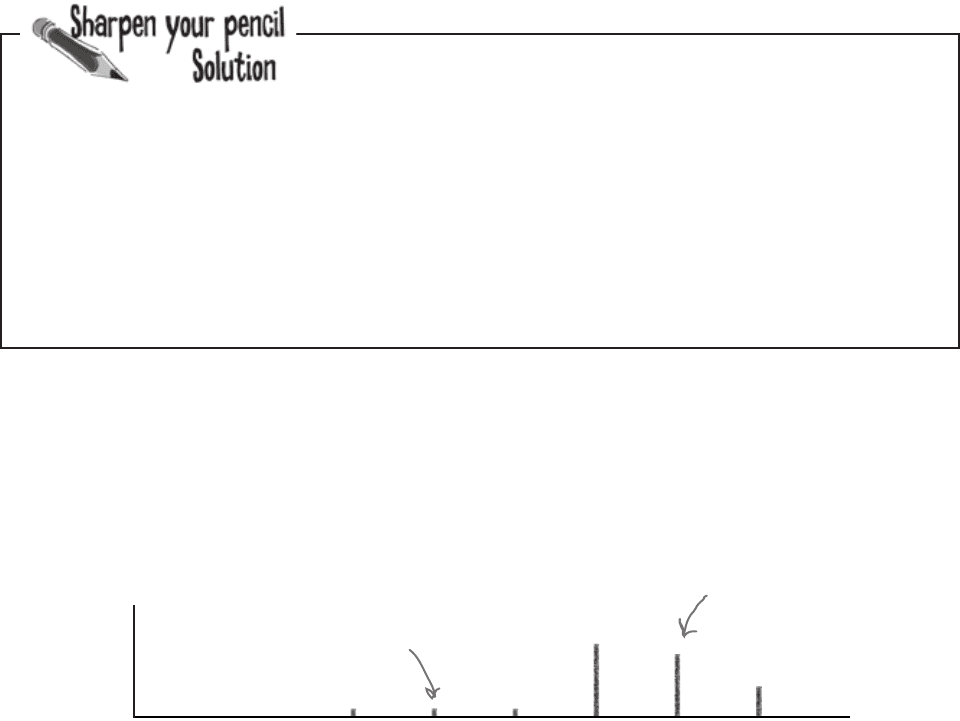
524 Chapter 13
If the drug cures 90% of people, how many people in the sample
of 15 snorers would you expect to have been cured? How does
this compare with the doctors results? What sort of distribution
do you think this follows?
11 12 13 1410 15
This is how many people should
have been cured, according to
the drug company.
90% of 15 is 13.5, so you’d expect 14 people to be cured. Only 11 people in the doctors sample were cured, which is
much lower than the result you’d expect
There are a specific number of trials and the doctor is interested in the number of successes, so the number of
successes follows a binomial distribution. If X is the number of successes then X ~ B(15, 0.9).
So what’s the problem?
Here’s the probability distribution for how many people the drug
company says should have been cured by the snoring remedy.
The number of people cured by SnoreCull in the doctor’s sample
is actually much lower than you’d expect it to be. Given the claims
made by the drug company, you’d expect 14 people to be cured,
but instead, only 11 people have been.
So why the discrepancy?
P(X = x)
x
This is how many people were
actually cured by SnoreCull.
sharpen solution
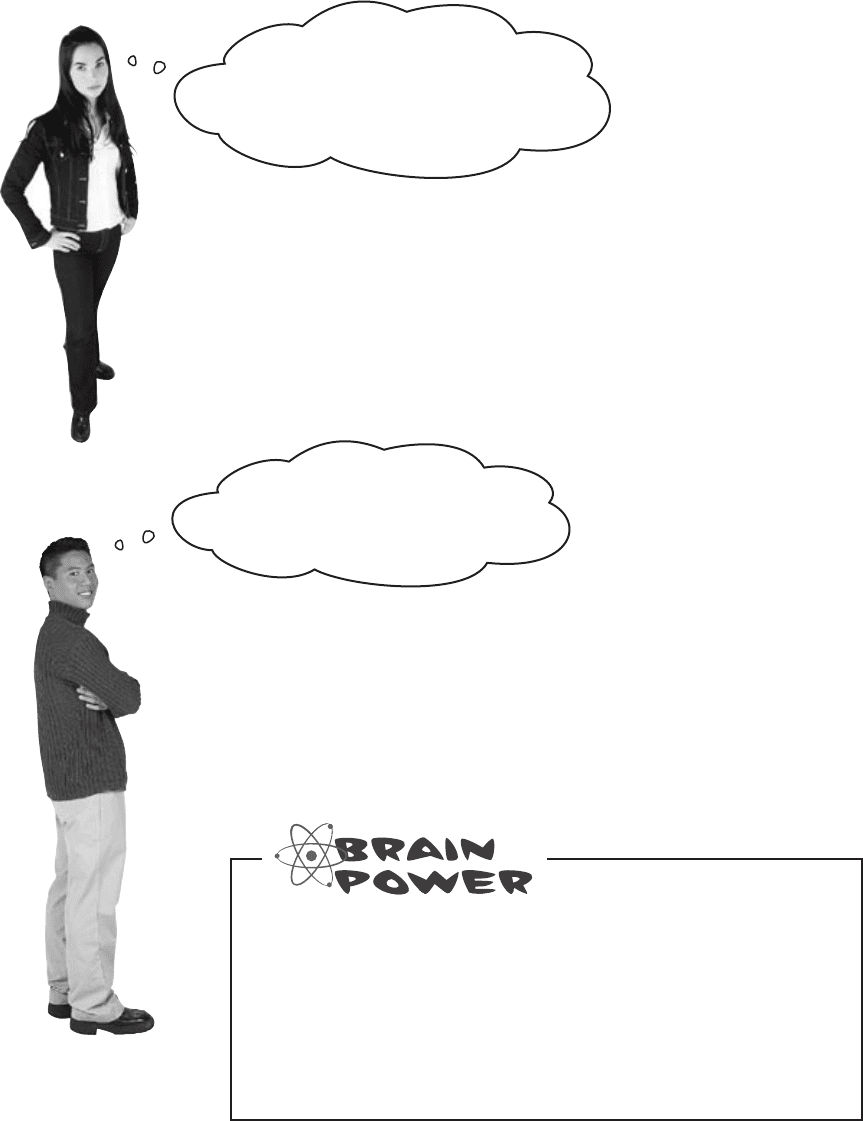
you are here 4 525
using hypothesis tests
But can we really be certain
that the drug company is at fault?
Maybe the doctor was unlucky.
The drug company’s claims might actually be accurate.
Rather than the drug company being at fault, it’s always possible that the
patients in the doctor’s sample may not have been representative of the
snoring population as a whole. It’s always possible that the snoring remedy does
cure 90% of snorers, but the doctor just happens to have a higher proportion
of people in her sample whom it doesn’t cure. In other words, her sample might
be biased in some way, or it could just come down to there being a small
number of patients in the sample.
Does that mean that the drug
company is telling lies about their
product? Shouldn’t the drug have
cured more of the doctor’s patients?
The drug company might not be deliberately telling lies,
but their claims might be misleading.
It’s possible that the tests of the drug company were flawed, and this might
have resulted in misleading claims being made about SnoreCull. They may
have inadvertent conducted flawed or biased tests on SnoreCull, which
resulted in them making inaccurate predictions about the population.
If the success rate of SnoreCull is actually lower than 90%, this would explain
why only 11 people in the sample were cured.
How do you think we can resolve this? How can we
determine whether to trust the claims of the drug
company, or accept the doctor’s doubts instead?
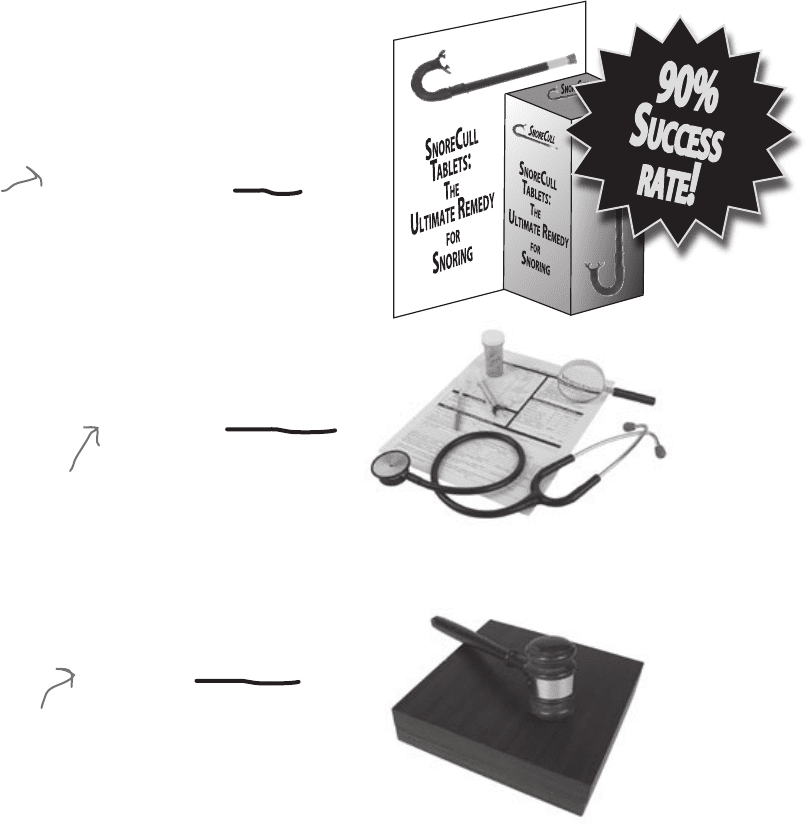
526 Chapter 13
Resolving the conflict from 50,000 feet
So how do we resolve the conflict between the doctor and the drug
company? Let’s take a very high level view of what we need to do.
We can resolve the conflict between the drug company and the doctor by
putting the claims of the drug company on trial. In other words, we’ll accept
the word of the drug company by default, but if there’s strong evidence
against it, we’ll side with the doctor instead.
Here’s what we’ll do:
Take the claim of
the drug company.
See how much evidence we need to
reject the drug company’s claim, and
check this against the evidence we
have. We do this by looking at how
rare the doctors results would be if
the drug company is correct.
Depending on the evidence,
accept or reject the claims of
the drug company.
In general, this process is called hypothesis testing, as you take a
hypothesis or claim and then test it against the evidence. Let’s look at
the general process for this.
Examine the claim
Examine the evidence
Make a decision
S
nore
C
ull
S
nore
C
ull
48 T
ableTS
the hypothesis testing process
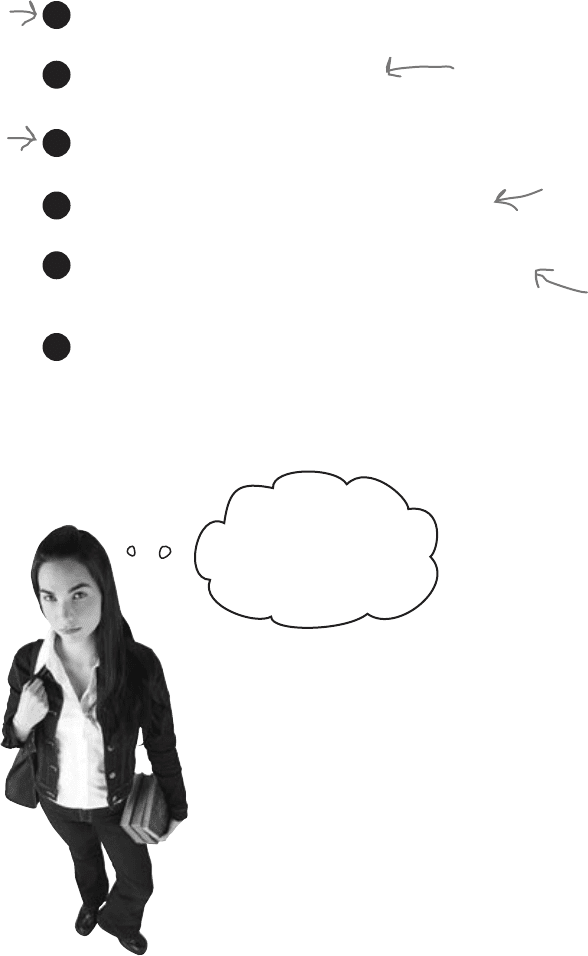
you are here 4 527
using hypothesis tests
The six steps for hypothesis testing
Here are the broad steps that are involved in hypothesis testing. We’ll go
through each one in detail in the following pages.
Why all the
formality? It’s
obvious there’s
something going on.
We need to make sure we properly test the drug
claim before we reject it.
That way we’ll know we’re making an impartial decision either way,
and we’ll be giving the claim a fair trial. What we don’t want to to do
is reject the claim if there’s insufficient evidence against it, and this
means that we need some way of deciding what constitutes sufficient
evidence.
Decide on the hypothesis you’re going to test
Choose your test statistic
Find the p-value of the test statistic
Determine the critical region for your decision
See whether the sample result is within the
critical region
Make your decision
1
2
3
4
5
6
This is the
claim that we’re
putting on trial
We need to pick the statistic that
best tests the claim.
We need a
certain level of
certainty.
We need to see how rare our results
are, assuming the claims are true.
We then see if it’s within
our bounds of certainty.
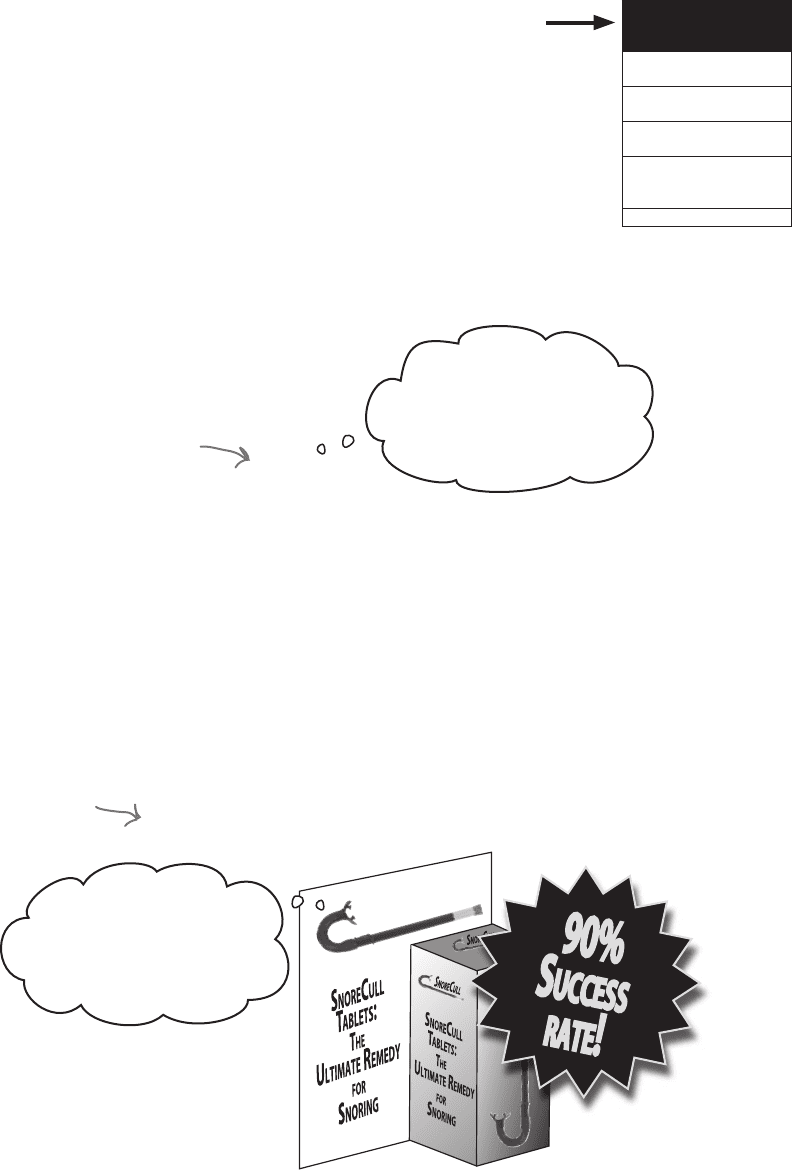
528 Chapter 13
H
0
So what’s the null hypothesis for SnoreCull?
The null hypothesis for SnoreCull is the claim of the drug company: that it
cures 90% of patients. This is the claim that we’re going to go along with,
unless we find strong evidence against it.
We need to test whether at least 90% of patients are cured by the drug, so this
means that the null hypothesis is that p = 90%.
The drug company’s claim
According to the drug company, SnoreCull cures 90% of patients within
2 weeks. We need to accept this position unless there is sufficiently strong
evidence to the contrary.
The claim that we’re testing is called the null hypothesis. It’s represented
by H
0
, and it’s the claim that we’ll accept unless there is strong evidence
against it.
I’m the null
hypothesis. I’m the
default position. If you
think I’m wrong, gimme
the evidence.
Step 1: Decide on the hypothesis
Let’s start with step one of the hypothesis test, and look at the key claim we
want to test. This claim is called a hypothesis.
The null hypothesis is the claim you’re
going to test. It’s the claim you’ll accept
unless there’s strong evidence against it.
H
0
: p = 0.9
This is the null hypothesis
for the SnoreCull trial.
Decide on the
hypothesis you’re going
to test
Choose your test
statistic
Determine the critical
region for your decision
Find the p-value of the
test statistic
See whether the
sample result is within
the critical region
Make your decision
You
are
Here
S
nore
C
ull
S
nore
C
ull
48 T
ableTS
You have to assume I cure
90% of people unless you
can come up with good
evidence that I don’t.
null and alternate hypotheses
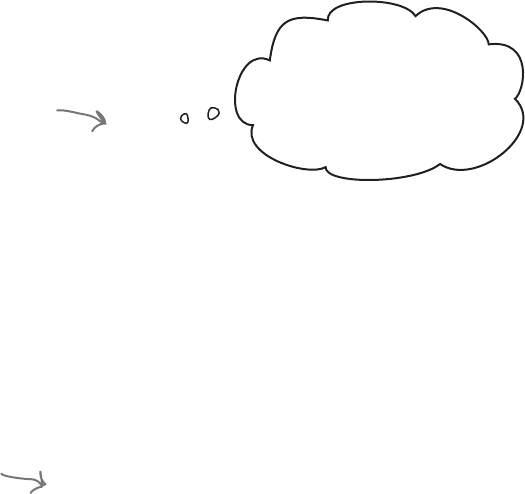
you are here 4 529
using hypothesis tests
The doctor’s perspective
The doctor’s view is that the claims of the drug company are too good to be
true. She doesn’t think that as many as 90% of patients are cured. She thinks
it’s far more likely that the cure rate is actually less than 90%.
The counterclaim to the null hypothesis is called the alternate hypothesis.
It’s represented by H
1
, and it’s the claim that we’ll accept if there’s strong
enough evidence to reject H
0
.
I’m the alternate
hypothesis. If H
0
let’s
you down, then you’ll
have to accept that
you’re better off with
Now that we have the null and alternate hypotheses for the SnoreCull
hypothesis test, we can move onto step 2.
So what’s the alternative?
We’ve looked at what the claim is we’re going to test, the null hypothesis, but
what if it’s not true? What’s the alternative?
H
1
The alternate hypothesis is the
claim you’ll accept if you reject H
0
.
The alternate hypothesis for SnoreCull
The alternate hypothesis for SnoreCull is the claim you’ll accept if the drug
company’s claim turns out to be false. If there’s sufficiently strong evidence
against the drug company, then it’s likely that the doctor is right.
The doctor believes that SnoreCull cures less than 90% of people, so this
means that the alternate hypothesis is that p < 90%.
H
1
: p < 0.9
This is the alternate
hypothesis for the
SnoreCull trial

530 Chapter 13
Q:
Why are we assuming the null hypothesis is
true and then looking for evidence that it’s false?
A: When you conduct a hypothesis test, you, in effect,
put the claims of the null hypothesis on trial. You give
the null hypothesis the benefit of the doubt, but then you
reject it if there is sufficient evidence against it. It’s a bit
like putting a prisoner on trial in front of a jury. You only
sentence the prisoner if there is strong enough evidence
against him.
Q:
Do the null hypothesis and alternate
hypothesis have to be exhaustive? Should they
cover all possible outcomes?
A: No, they don’t. As an example, our null hypothesis
is that p = 0.9, and our alternate hypothesis is that
p < 0.9. Neither hypothesis allows for p being greater
than 0.9.
Q:
Isn’t the sample size too small to do this
hypothesis test?
A: Even though the sample size is small, we can still
perform hypothesis tests. It all comes down to what test
statistic you use — and we’ll come to that on the next
page.
Q:
So are hypothesis tests used to prove whether
or not claims are true?
A: Hypothesis tests don’t give absolute proof. They
allow you to see how rare your observed results actually
are, under the assumption that your null hypothesis
is true. If your results are extremely unlikely to have
happened, then that counts as evidence that the null
hypothesis is false.
no dumb questions
When hypothesis testing, you assume the null hypothesis
is true. If there’s sufficient evidence against it, you reject
it and accept the alternate hypothesis.
